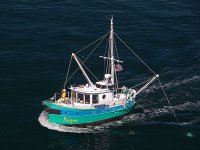Marco Flamingo":1m0xcyk2 said:
Bob,
The helm is set up for twins? What am I missing here?
Unlike a home built airplane that has FAA certification, I don't believe that a home built boat requires USCG cert, State cert, a NA stamp, welding certification, etc. You put it in the water and see if the welds hold. It seems to be priced with that in mind.
Mark
Mark, you are correct that there are two control binnacles at the helm station. I have no idea why--since there is a single diesel on the midline, with a single drive shaft going to a single prop in the other photos. The plans for the "Union Jack" describe her as a semi displacement vessel, and don't seem to have twin screw options.
One option that many trawlers have is to put in an auxiliary engine--usually a separate shaft and prop, or a auxiliary drive to the main shaft (chain, belt or hydraulic). I don't see any evidence of that in the photos or description here. But looking at the stern view, there is apparently an outboard bracket welded there, so I presume that he was planning to put an outboard auxiliary.
One item which set alarm bells off is photo #11: Note the drive shaft--two universal joints, jury rigged of the output of the transmission, and especially the small piece of shaft in the middle...looks like problems to me down the line or sooner.
Yes, if it floats you can take it on the water...I suspect that the welds are good enough for what it is--but there are several issues--one is the type of rod used vs the steel in the plating, and corrosion. What if there is a blow to the side of the boat, will the welds hold?
At one time we had a slip right next to Long Beach Alamitos Bay marine ship yard. It was a popular place for Home built boats to be launched. There were some real abortions--including several that sank at the dock within the first 48 hours. I remember one 45 footer, which had basically 2x4 frames, and lattice planks (5/16" x 1.5"), covered by a single layer of fiberglass cloth set in epoxy. It sank the first night.




